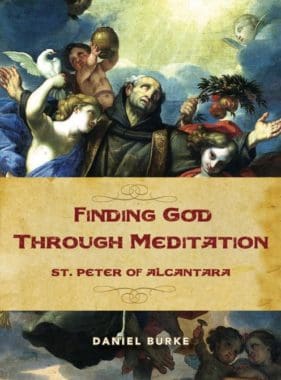 In 1577, St. Teresa of Avila completed what is heralded as her seminal work on mental prayer, meditation, and contemplation in the Interior Castle. This guidebook to the most profound depths of prayer has become the standard against which all serious inquiries into interior progress must be measured. This is the reason that it is to St. Teresa that the Catechism of the Catholic Church poses the question, “What is contemplative prayer?”
In 1577, St. Teresa of Avila completed what is heralded as her seminal work on mental prayer, meditation, and contemplation in the Interior Castle. This guidebook to the most profound depths of prayer has become the standard against which all serious inquiries into interior progress must be measured. This is the reason that it is to St. Teresa that the Catechism of the Catholic Church poses the question, “What is contemplative prayer?”
It is in the fourth mansion of the Interior Castle that the author of this work, the holy Franciscan Friar, Peter of Alcántara, through his writings and relationship with St. Teresa, collaborates with her in an important exchange that should impact the way we view prayer today.
 This collaboration arose from a dispute involving individuals positing to St. Teresa that a soul seeking to advance in prayer should work to manage thoughts or guide the mind to silence or stillness during prayer. Those advancing this idea cited St. Peter’s writings as proof of the veracity of their claims.
This collaboration arose from a dispute involving individuals positing to St. Teresa that a soul seeking to advance in prayer should work to manage thoughts or guide the mind to silence or stillness during prayer. Those advancing this idea cited St. Peter’s writings as proof of the veracity of their claims.
Owing to her knowledge of and respect for St. Peter, as he was one of her spiritual directors, St. Teresa desired to ensure that her thinking on the matter was correct. She turned to the text you now hold to resolve the dispute.
After her investigation, St. Teresa, not known for timidity of expression and emboldened by her union with St. Peter, attacked these false teachings with a notable force that should elicit our careful attention.
St. Teresa, in the third chapter of the fourth mansion of the Interior Castle, argued four key points against using any method that is excessively focused on thought management during prayer. In summary, she argues that recollection is a loving awareness of the Lord that comes in the form of a gift and not as a result of spiritual gymnastics. Teresa argues that, as we become absorbed in the Lord, it is insufficient, stifling, frustrating and even dangerous to strive for some inert state of consciousness in which we act against our desire to understand. Instead of a state of consciousness, she encourages us to seek a loving friendship with God:
1) Deeper prayer does not require that we manage our thoughts (which she calls “human industry”) but that we seek to simply and humbly yield to the work of the Lord. Otherwise, she argues, the result will be that we further exacerbate the normal challenges of prayer.
2) Deeper prayer comes through a resignation to the will to God. This resignation brings peace, whereas human efforts bring frustration. Psychologically coercing ourselves to inactivity disturbs the true peace that the Lord wants to grant. Peace is a matter of bringing our created will into harmony with the loving Will that created it. Teresa, who understands the delicacy of spousal friendship with the Lord, is aware that on this point true peace requires a completely free response of the heart to the Lord’s self-disclosure. When we do not give space to the heart to make such a free response through petitionary prayer and meditation, we are trying to surmount the movements God Himself has inspired in it. Such coercion always does more harm than good.
3) “Because the same care which is employed for thinking on nothing, will, perhaps, excite the imagination to think much” instead. The effort to achieve a state of thoughtlessness can exacerbate the soul into thinking in even more distracting ways than otherwise would have been the case. We become aware that we are thinking not to think or else that we have achieved a state of thoughtlessness. But this awareness of our own mental activity or inertia, whether self-congratulatory or condemning, attends not to God or what He discloses but to self. It is locked in an orbit around one’s own big fat ego, unable to break free of its self-awareness even when it is not self-aware.
4) “Because the most pleasing and substantial service we can do for God is to have only His honor and glory in view, and to forget ourselves, our own benefit, delight, and pleasure.” Pursuing a psychic state can be a preoccupation and distraction when our attention should be on the Lord and on responding to His Presence. This is the same problem addressed in Teresa’s third point, but presented from the perspective of our friendship with God, the perspective out of which she begins her critique. If we are self-occupied with self-awareness or lack of self-awareness, thinking or not thinking, understanding or not understanding, we have already lost sight of the Lord. Our prayer is not a response of love to the One who loves us. Rather than the devotion of friendship and awareness of the otherness of God, rather than being vulnerable to adoration before the wonder of the Lord, we have fixated on things that will never expand the heart or allow it to be humble before Him.
Teresa continues her argument with the admonition that we should not seek to “charm our faculties” into some false state of readiness for God, but that if our mind or faculties are ever to be suspended or managed, then the valid impetus or force to achieve such an end comes from God alone. We need do nothing but simply turn our attention to Him and occupy our minds with Him in prayer, which is the central thrust of this book and of the practice of authentic Christian meditation.
Why was this so important to Teresa then, and why is it important to us now? We live in a period that is just as obsessed with methods of prayer and false teaching on prayer as it was then. In keeping with our lower nature, we look for secret, easy formulas to success; five ways to a better this, and four quick and easy ways to a better that. As with modern weight loss schemes, these methods leave the wallet thinner and the soul no closer to the fulfillment of what it truly needs and desires. St. Peter of Alcántara’s work is as sure an antidote to much of the false teaching of our day as it was in his own.
St. Peter’s insights on prayer are far more profound and far-reaching than the size of this text might suggest. The reader will find not only help in satisfying the short-term need for insight on how to grow in prayer, but also a window into perspectives on prayer that should challenge and enrich the reader for years to come.
In particular, St. Peter is not afraid to call us to a deeper commitment to self-denial and ascetical practices as we pursue a deeper life of prayer and devotion. Many in our time criticize or downplay traditional asceticism, but if we believe St. Teresa’s account of St. Peter’s appearance to her after his death, it seems that God also approved of his approach. We also have affirmation of his ascetical counsels affirmed and even more deeply explored in the writings of St. John of the Cross.
One of the greatest benefits of our time with respect to theological clarity is St. John Paul II’s gift of the Catechism of the Catholic Church. In part four entitled Christian Prayer, we have a beautiful and concise summary of all of the most important aspects of the Church’s understanding of prayer. Here, in the Catechism, we see distinctions made between three expressions of prayer: vocal prayer, meditation, and contemplation. This clarity allows us to better understand the progressive nature of the development of prayer and corrects a number of past and present errors. It also sheds light on and reinforces St. Peter’s use of the terms “meditation” and “contemplation.”
St. Peter’s use of the term “meditation” falls squarely in line with the Catechism wherein it reveals:
2705 Meditation is above all a quest. The mind seeks to understand the why and how of the Christian life, in order to adhere and respond to what the Lord is asking. The required attentiveness is difficult to sustain. We are usually helped by books, and Christians do not want for them: the Sacred Scriptures, particularly the Gospels, holy icons, liturgical texts of the day or season, writings of the spiritual fathers, works of spirituality, the great book of creation, and that of history–the page on which the “today” of God is written.
2706 To meditate on what we read helps us to make it our own by confronting it with ourselves. Here, another book is opened: the book of life. We pass from thoughts to reality. To the extent that we are humble and faithful, we discover in meditation the movements that stir the heart and we are able to discern them. It is a question of acting truthfully in order to come into the light: “Lord, what do you want me to do?”
2707 There are as many and varied methods of meditation as there are spiritual masters. Christians owe it to themselves to develop the desire to meditate regularly, lest they come to resemble the three first kinds of soil in the parable of the sower. But a method is only a guide; the important thing is to advance, with the Holy Spirit, along the one way of prayer: Christ Jesus.
2708 Meditation engages thought, imagination, emotion, and desire. This mobilization of faculties is necessary in order to deepen our convictions of faith, prompt the conversion of our heart, and strengthen our will to follow Christ. Christian prayer tries above all to meditate on the mysteries of Christ, as in lectio divina or the Rosary. This form of prayerful reflection is of great value, but Christian prayer should go further: to the knowledge of the love of the Lord Jesus, to union with him.
St. Peter also clearly acknowledges meditation as a transitional form of prayer (as do all faithful spiritual theologians) that draws us ever more deeply into relationship with God. With God’s grace, we eventually transition out of this mode of prayer, into a more simple prayer, and then to what is known as infused contemplation. St. Peter clarifies this process. In his discussion of contemplation, he uses the term “contemplation” to refer to either acquired/natural contemplation or affective meditation. However, he is particularly clear on this matter in his eighth counsel on meditation, where he reveals the right understanding of a kind of contemplation that is much different than what can be known in meditation and is in keeping with St. Teresa’s understanding of contemplation.
 The importance of this clarity is a matter of significance in our time. As Ignatian spirituality has emerged as a dominant expression today, a particular form of Ignatian meditation has become very popular. This approach to prayer has and will continue to bear much fruit in the lives of those who diligently engage with the practice, especially in the manner proposed by St. Peter. It is a form of prayer that is important to help beginners emerge through and then out of the purgative phase of spiritual growth into the illuminative phase. This transition, most clearly revealed in the writings of St. John of the Cross, is one whereby the pilgrim, once deeply blessed by meditation, leaves it behind in favor of a contemplation wherein God rewards their diligent ascesis and devotion by drawing them into a form of prayer that has little to do with human will or action and much more to do with God’s work of transformative grace in the soul.
The importance of this clarity is a matter of significance in our time. As Ignatian spirituality has emerged as a dominant expression today, a particular form of Ignatian meditation has become very popular. This approach to prayer has and will continue to bear much fruit in the lives of those who diligently engage with the practice, especially in the manner proposed by St. Peter. It is a form of prayer that is important to help beginners emerge through and then out of the purgative phase of spiritual growth into the illuminative phase. This transition, most clearly revealed in the writings of St. John of the Cross, is one whereby the pilgrim, once deeply blessed by meditation, leaves it behind in favor of a contemplation wherein God rewards their diligent ascesis and devotion by drawing them into a form of prayer that has little to do with human will or action and much more to do with God’s work of transformative grace in the soul.
Much more can be said about the value of this great gift of meditation to the Church. This text is so clear that the reader should have little trouble finding the gems that God has in store for all who truly desire to grow in relationship with Him in prayer.
Note from Dan: This excerpt is taken from my newly published version of St. Peter of Alcántara’s great work on Prayer and Meditation entitled “Finding God Through Meditation.” If you would like a signed copy of this book (by me, not St. Peter), CLICK HERE. Your donation for the book will go to the formation of priests, religious, and the faithful poor. If you would just like to buy a copy from Emmaus Road Publishing, CLICK HERE.
+
Art for this post regarding false teachings on meditation and contemplation: Detail of Teresa of Avila, François Gérard, 1827; San Pedro de Alcántara (Saint Peter of Alcántara), Luis Tristan, 1st quarter of 17th century; both PD-US author’s life plus 100 years or less; both Wikimedia Commons. Cover of Finding God Through Meditation used with permission.




